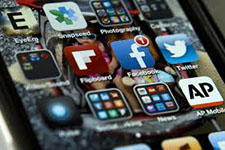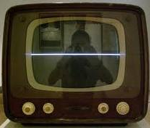Time to get back into the swing of things. Over the last few months I’ve been “experiencing” the internet rather than writing about it, i.e., observing it. Being a developer I don’t just get to “see” what’s happening I can make it happen too. However, it is pretty easy to get lost in the trees when exploring the forest, so every so  often I have to step back a little and take a look at the big picture. As notably predicted for the last 25 years, not only in my own observations, but countless others, the World Wide Web, better known as the “Internet”, is rapidly becoming the backbone of today’s media…and no, not just social media…all media. But that is not the realization that I’m going to write about. As far as it goes, that is not even a realization as a statement of the obvious. The realization comes from the fact that for the first time the “media” is separating from the “medium” but the messages must still remain in tact.
often I have to step back a little and take a look at the big picture. As notably predicted for the last 25 years, not only in my own observations, but countless others, the World Wide Web, better known as the “Internet”, is rapidly becoming the backbone of today’s media…and no, not just social media…all media. But that is not the realization that I’m going to write about. As far as it goes, that is not even a realization as a statement of the obvious. The realization comes from the fact that for the first time the “media” is separating from the “medium” but the messages must still remain in tact.
“The medium is the message” is a phrase coined by Marshall McLuhan meaning that the form of a medium embeds itself in the message, creating a symbiotic relationship by which the medium influences how the message is perceived.
http://en.wikipedia.org/wiki/The_medium_is_the_message
Two hundred years ago, carrier pigeons were the best way to get the news…depending on where you were of course, but the message was confined to the characteristics of the pigeons. If a particular pigeon was not necessarily a home body or fell in love with a lovely little pheasant along the way, it was entirely possible the message could be lost. Technology has been seeking the perfect “lossless” protocol ever since. But to make a long story short to transmit information via pigeon, you needed a pigeon. To send telegrams you needed a telegraph. To read a paper you needed a printing press. To listen to radio broadcasts you needed a radio. To watch a movie, you needed a theatre and last but not least to watch television…well you know where I’m headed.
transmit information via pigeon, you needed a pigeon. To send telegrams you needed a telegraph. To read a paper you needed a printing press. To listen to radio broadcasts you needed a radio. To watch a movie, you needed a theatre and last but not least to watch television…well you know where I’m headed.
As the Internet becomes the “Net”, the universal medium that now carries messages, images, text, news, movies, television, you name it, the “media” now has to conform to a multitude of platforms of all shapes and sizes…not just one. But as the medium becomes more universal, everything from your mobile phone to your refrigerator will eventually be attached to the ‘Net’… a good deal of thought now has to be put into the form as well as the substance. Using a telegraph meant clicking the clicky thing, short for a dot, long for a dash…and that’s it. Hopefully, the tapper and tappee at either end had the skills to both send and decode the message. The medium only had to convey that message using its own unique protocol.
Now the protocol is becoming universal.. HTTP.. but the devices are becoming more complex, in other words, its the “clicky” things that are changing, becoming more diverse. Do you want to receive your messages on your laptop, your mobile phone, your television, your refrigerator? All these are possible now and each platform has to be taken into account on its own merits. Each platform, though connected to the web still has its own unique characteristics, functions and abilities than can be taken advantage of when consuming that message. Your laptop, can organize your messages, your mobile can notify you when they arrive, you’re refrigerator can order a quart of milk from shop.com when it “notices” you need it.  The possibilities are endless. So are the choices modern web designers/developers have to make. Hence, the continuing rise of the new generation of “User Experience Designers”. The catch phrase for technology professionals in the early 21st century. It is the User Experience Designer that has to figure out, given a single message, how that message will be perceived, viewed, collected and stored not by the medium but by the device attached to the medium, your browser, your tablet, your mobile phone, your toaster…whatever.
The possibilities are endless. So are the choices modern web designers/developers have to make. Hence, the continuing rise of the new generation of “User Experience Designers”. The catch phrase for technology professionals in the early 21st century. It is the User Experience Designer that has to figure out, given a single message, how that message will be perceived, viewed, collected and stored not by the medium but by the device attached to the medium, your browser, your tablet, your mobile phone, your toaster…whatever.
The foot soldier in all this will be the hardworking, every-present, ubiquitious “App”, made popular by the Apple eco-system and now sweeping through the universe at light speed. There are apps for everything, keeping in touch, hiding in secret, collecting bitcoins and selling old socks. You name it, there has to be an app for it. In digital advertising, clever slogans and fancy jingles have given way to the “app”. You can’t just sell dog food, you have to have an app that will keep track of Fido’s calorie in-take and weight. The “app” has to be in as much demand as the product you’re selling! That can be a pretty tall order. And from an insiders point of view, before one can even begin to explore actually creating an app, the first and most important question to ask is “Web or Native”?
This has been and will continue to be an ongoing debate for years to come. As the Internet continues to change human culture, all these new devices and capabilities are creating cultures of their own. Its not enough just get a text message, If I have an Iphone I want an Iphone text message. If I’m team  android I want an android text message. If I’m on my laptop do I want a Safari or Chrome or (God forbid) an Internet Explorer message? It may seem trivial but its not. Developing apps used to be a simple matter of knowing a technology that was both reasonably popular and that you had or could acquire some familiarity with. Not any more. We no longer deal just in the technology realm alone but the “culture” of technology. Apps can be, but are no longer expected to be, monolithic. Facebook is Facebook on your laptop, but is it still Facebook on your Iphone? On your Samsung? On your toaster?
android I want an android text message. If I’m on my laptop do I want a Safari or Chrome or (God forbid) an Internet Explorer message? It may seem trivial but its not. Developing apps used to be a simple matter of knowing a technology that was both reasonably popular and that you had or could acquire some familiarity with. Not any more. We no longer deal just in the technology realm alone but the “culture” of technology. Apps can be, but are no longer expected to be, monolithic. Facebook is Facebook on your laptop, but is it still Facebook on your Iphone? On your Samsung? On your toaster?
That’s right, what If I want my toaster to post to my Facebook timeline.. “the toast is done”. That may seem far fetched, but wouldn’t that be a good idea if I were Braun, or more importantly SELLING Braun toasters. Here the question of “Web or Native” goes well beyond just a matter of technology, but to once  again returning, in no small way, to the “medium is the message”! Given my 1000 word limit. I won’t go into the debate itself in this article. But it will be the source of articles to come.. .stay tuned! (On the device of your choice, of course!)
again returning, in no small way, to the “medium is the message”! Given my 1000 word limit. I won’t go into the debate itself in this article. But it will be the source of articles to come.. .stay tuned! (On the device of your choice, of course!)

 technologies lie hidden behind all the social networks, websites, video ads, etc. they consume, the folks that actually earn a living putting all those things together do. To the developers, programmers, producers and project managers of the world this is neither hype nor magic, its how they feed their families. Developing the skills required to build any of the dazzling applications that come across your browser takes time (sometimes a lot of time), energy, dedication and no small amount of money to learn. So if digital development is your chosen field of endeavor, picking the right technology to “float your boat” in is a major investment!
technologies lie hidden behind all the social networks, websites, video ads, etc. they consume, the folks that actually earn a living putting all those things together do. To the developers, programmers, producers and project managers of the world this is neither hype nor magic, its how they feed their families. Developing the skills required to build any of the dazzling applications that come across your browser takes time (sometimes a lot of time), energy, dedication and no small amount of money to learn. So if digital development is your chosen field of endeavor, picking the right technology to “float your boat” in is a major investment! For example, there is not a soul alive, layman, technologist, or advertising maven that will deny the overwhelming effect the mobile phone has, is and will have on our daily lives. But like the television, or even the radio, how many of us actually know how it works? Once a handy item to avoid pay phones (now nearly extinct) they have become as part of how we live our lives as where we work and what we wear. We use them to locate, placate, associate and communicate…every single day. Yet we still think of the “technology” as the actual device itself and not the all important “innards”. An iphone is an iphone right?
For example, there is not a soul alive, layman, technologist, or advertising maven that will deny the overwhelming effect the mobile phone has, is and will have on our daily lives. But like the television, or even the radio, how many of us actually know how it works? Once a handy item to avoid pay phones (now nearly extinct) they have become as part of how we live our lives as where we work and what we wear. We use them to locate, placate, associate and communicate…every single day. Yet we still think of the “technology” as the actual device itself and not the all important “innards”. An iphone is an iphone right? With that in mind, picking the right kind of software a software professional should know can make all the difference between standing in line for your IPO or standing in line for your bread! With that said, how do software professionals choose which set of skills they need? The ubiquitous answer is the “marketplace”. Yes, we’re back to the world of Adam Smith and the “free hand” taking control of our economic lives ( see the article “We’re off to see the Widget, June, 2009
With that in mind, picking the right kind of software a software professional should know can make all the difference between standing in line for your IPO or standing in line for your bread! With that said, how do software professionals choose which set of skills they need? The ubiquitous answer is the “marketplace”. Yes, we’re back to the world of Adam Smith and the “free hand” taking control of our economic lives ( see the article “We’re off to see the Widget, June, 2009  After all, that’s why we’re online, on the phone, and on the go in the first place. The world is becoming a 24 hour odeon for entertainment, information and just a cool place to be, even when you’re “relaxing” at home. The hardware will be telephones, televisions, computers, refrigerators and coffee pots, but guess what? Its going to be the software that holds it all together across so many different kinds of platforms. But which one? Remember the days of Microsoft vs. Apple, Digital Equipment vs. IBM, the Model T vs. the horse and buggy? So the race is on and everyone loves a good competition. Will it be Android or iOS? HTML 5 or Flash or Javascript? Will it be Xbox or Wii? Who knows!? My guess ALL of the above, at least for a little while.
After all, that’s why we’re online, on the phone, and on the go in the first place. The world is becoming a 24 hour odeon for entertainment, information and just a cool place to be, even when you’re “relaxing” at home. The hardware will be telephones, televisions, computers, refrigerators and coffee pots, but guess what? Its going to be the software that holds it all together across so many different kinds of platforms. But which one? Remember the days of Microsoft vs. Apple, Digital Equipment vs. IBM, the Model T vs. the horse and buggy? So the race is on and everyone loves a good competition. Will it be Android or iOS? HTML 5 or Flash or Javascript? Will it be Xbox or Wii? Who knows!? My guess ALL of the above, at least for a little while. Being Steve Jobs he can bend or even tilt the marketplace, but even he can’t break it. That’s left in the all-powerful hands of the consumer. However, what most consumers are unaware of is that most of the core technologies that run their precious gadgets have been around for decades, a lot longer than the actual devices themselves. Javascript has been with us since the 90s, Objective C, since the 80s, html (including “most” of html 5) has been around since the 70’s! Flash/Actionscript is actually the “baby” in this bunch!
Being Steve Jobs he can bend or even tilt the marketplace, but even he can’t break it. That’s left in the all-powerful hands of the consumer. However, what most consumers are unaware of is that most of the core technologies that run their precious gadgets have been around for decades, a lot longer than the actual devices themselves. Javascript has been with us since the 90s, Objective C, since the 80s, html (including “most” of html 5) has been around since the 70’s! Flash/Actionscript is actually the “baby” in this bunch! In my mind, there’s room enough for everybody! If you don’t know what AJAX is, don’t worry about it. No, its not a powdered cleanser but it will play a significant role in your digital life whether you’re aware of it or not and right now a lot of developers are betting it will be their meal ticket to fame, fortune, and some all new gadgers of their own. We’ll see…we’ll see….
In my mind, there’s room enough for everybody! If you don’t know what AJAX is, don’t worry about it. No, its not a powdered cleanser but it will play a significant role in your digital life whether you’re aware of it or not and right now a lot of developers are betting it will be their meal ticket to fame, fortune, and some all new gadgers of their own. We’ll see…we’ll see….
 in the Wall Street Journal and Financial Times. Not a good thing. Now the CEOS and Marketing VPs feel compelled to take sides…sides in a battle they know very little, if anything, about. The “techies”, the guys who are supposed to know the difference between h.264 and “Ogg”, are drowned out by the siren of the wielders of the purse strings. “We heard flash is dead, can we an HTML 5 player please, expecting, of course, that not will the vaunted HTML 5 play as well flash video, but even BETTER! Better being subjective, but sooner or later, being put in bean counter terminology for either saving or making money. But this assumption has absolutely no basis on anything other than what they read in the latest New York Times technology page.
in the Wall Street Journal and Financial Times. Not a good thing. Now the CEOS and Marketing VPs feel compelled to take sides…sides in a battle they know very little, if anything, about. The “techies”, the guys who are supposed to know the difference between h.264 and “Ogg”, are drowned out by the siren of the wielders of the purse strings. “We heard flash is dead, can we an HTML 5 player please, expecting, of course, that not will the vaunted HTML 5 play as well flash video, but even BETTER! Better being subjective, but sooner or later, being put in bean counter terminology for either saving or making money. But this assumption has absolutely no basis on anything other than what they read in the latest New York Times technology page.
 And whether we like it or not, as the Internet redefines “traditional” media, its going to redefine the “traditional” commercial, as well, whether it uses HTML 5, or Flash or snake oil. The leaders, the visionaries, the creative minds of the media world need to focus on those new definitions. Its the technologist’s job to find and use the right technologies to make those new definitions work. “Hype” is now and always will be a part of our way of life, but let the hype follow the flow of the ideas and not the hammer and nails that put them together. Different tools do different jobs in different ways, that’s all. Some tools are better at some jobs than others. But, for the most part, any tool does much better without the hype.
And whether we like it or not, as the Internet redefines “traditional” media, its going to redefine the “traditional” commercial, as well, whether it uses HTML 5, or Flash or snake oil. The leaders, the visionaries, the creative minds of the media world need to focus on those new definitions. Its the technologist’s job to find and use the right technologies to make those new definitions work. “Hype” is now and always will be a part of our way of life, but let the hype follow the flow of the ideas and not the hammer and nails that put them together. Different tools do different jobs in different ways, that’s all. Some tools are better at some jobs than others. But, for the most part, any tool does much better without the hype. and I’m sure designers feel the same way about developers. Its just the nature of the business that these diverse poles, although in desperate need of each other, still follow “ne’er the twain shall meet”. But they do meet. Somewhere along the line, in anything you see on the Internet that can be considered “professional”, is the blending of the two. Even in cutting edge agencies, this is usually attributed to some kind of magic that bridges the gulf between the creative and the functional.
and I’m sure designers feel the same way about developers. Its just the nature of the business that these diverse poles, although in desperate need of each other, still follow “ne’er the twain shall meet”. But they do meet. Somewhere along the line, in anything you see on the Internet that can be considered “professional”, is the blending of the two. Even in cutting edge agencies, this is usually attributed to some kind of magic that bridges the gulf between the creative and the functional.  Everything you see on the Internet (and most technologies since the radio) are electronic impulses doing their thing and our uncanny ability to turn that into actual communication; sights and sounds that have meaning to human ears, eyes and brains. This is truly remarkable since there is a mighty big leap between a random electron and bringing a smile to someone’s face. Without that magic, we might as well be reading text in black and white, one page at a time. Where does that magic come from?
Everything you see on the Internet (and most technologies since the radio) are electronic impulses doing their thing and our uncanny ability to turn that into actual communication; sights and sounds that have meaning to human ears, eyes and brains. This is truly remarkable since there is a mighty big leap between a random electron and bringing a smile to someone’s face. Without that magic, we might as well be reading text in black and white, one page at a time. Where does that magic come from? to find out exactly. Lo and behold, there was no entry. So I added
to find out exactly. Lo and behold, there was no entry. So I added For some reason there is still the “great divide” between “technology” (hard-core nerds and weenies) and “creatives” (soft-core nerds and weenies). But that great divide becomes a just bit more narrow every time a “creative” learns how to build an actionscript class or a techie adjusts a css property just ever so to get the right “effect”.
For some reason there is still the “great divide” between “technology” (hard-core nerds and weenies) and “creatives” (soft-core nerds and weenies). But that great divide becomes a just bit more narrow every time a “creative” learns how to build an actionscript class or a techie adjusts a css property just ever so to get the right “effect”. and “User Experience”
and “User Experience” were completely separate terms, seldom if ever used together, much less in the same breathe. But times are “a-changing” along with the vernacular and apparently the job specs.
were completely separate terms, seldom if ever used together, much less in the same breathe. But times are “a-changing” along with the vernacular and apparently the job specs.
 Ok, instead of the kids being across the street or down the block or in a neighborhood that had its own name, they could be anywhere in the world. He could be chatting it up and planning strategy with kids his own age or full-grown adults, all insid this ultimate fantasy come alive on a video screen. Is this leading to a more open, broad-minded world where my son will grow up and be influenced by lives and personalities thousands of miles away in some cases? Does this mean he’ll learn more, know more and do more by the time he finishes high school than I have yet to do in my entire lifetime? That would be nice, but something tells me it simply not that simple. My son my be interacting with people from all over the world but in reality he’s interacting with World of WarCraft and all the technologies that bring this wonder to millions. Its the technology that’s becoming a part of their lives…not each other.
Ok, instead of the kids being across the street or down the block or in a neighborhood that had its own name, they could be anywhere in the world. He could be chatting it up and planning strategy with kids his own age or full-grown adults, all insid this ultimate fantasy come alive on a video screen. Is this leading to a more open, broad-minded world where my son will grow up and be influenced by lives and personalities thousands of miles away in some cases? Does this mean he’ll learn more, know more and do more by the time he finishes high school than I have yet to do in my entire lifetime? That would be nice, but something tells me it simply not that simple. My son my be interacting with people from all over the world but in reality he’s interacting with World of WarCraft and all the technologies that bring this wonder to millions. Its the technology that’s becoming a part of their lives…not each other. Of course, that alone can mean many things to many people. But my guess is the magazine has lasted so long (..and apparently still going strong) because that’s something all young men (and most older ones) would truly want to be. Including me. And, although I’ve only read one article (on a company called Psyop but more on that later), I was thoroughly impressed.
Of course, that alone can mean many things to many people. But my guess is the magazine has lasted so long (..and apparently still going strong) because that’s something all young men (and most older ones) would truly want to be. Including me. And, although I’ve only read one article (on a company called Psyop but more on that later), I was thoroughly impressed. Its no coincidence they are in a position to go to a David Granger (Esquire’s E-C) and offer him a chance to leap out there on the “bleeding” edge of trendy. Its as trendy as you can get. And from my understanding of Esquire, that’s what has been keeping that particular boat floating for almost 80 years. Especially, in these days of publishing in “crisis”. Something tells me, Mr. Granger “gets it”.
Its no coincidence they are in a position to go to a David Granger (Esquire’s E-C) and offer him a chance to leap out there on the “bleeding” edge of trendy. Its as trendy as you can get. And from my understanding of Esquire, that’s what has been keeping that particular boat floating for almost 80 years. Especially, in these days of publishing in “crisis”. Something tells me, Mr. Granger “gets it”. quite as beguiling, but I’m betting the one with Gillian Jacobs walking around in her enormous bathroom with only her Brooks Brothers shirt on will garner a fair amount of “cyber” buzz. And if Brooks Bothers is paying any attention (probably not) , they should be doing their best to “sponsor” the next episode. In fact, Mr. Granger should be lining up sponsors left and right just on the “hype” factor alone. The intentions are clearly to go “viral” perhaps even landing on the Ad Age Viral Video Chart. The world of media is being rewritten and we are here to see it.
quite as beguiling, but I’m betting the one with Gillian Jacobs walking around in her enormous bathroom with only her Brooks Brothers shirt on will garner a fair amount of “cyber” buzz. And if Brooks Bothers is paying any attention (probably not) , they should be doing their best to “sponsor” the next episode. In fact, Mr. Granger should be lining up sponsors left and right just on the “hype” factor alone. The intentions are clearly to go “viral” perhaps even landing on the Ad Age Viral Video Chart. The world of media is being rewritten and we are here to see it. thing, and enjoyed it. Up to now, I had never heard of the guy and doubt that I ever would have. But not only do I remember the name, I’m writing it down. In one fell swoop, I was impressed, entertained and educated all at once. And I still haven’t read any of the articles! And you’re telling me this ISN’T the future?! Next up…”Holo-mercials”!
thing, and enjoyed it. Up to now, I had never heard of the guy and doubt that I ever would have. But not only do I remember the name, I’m writing it down. In one fell swoop, I was impressed, entertained and educated all at once. And I still haven’t read any of the articles! And you’re telling me this ISN’T the future?! Next up…”Holo-mercials”!